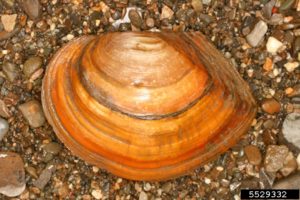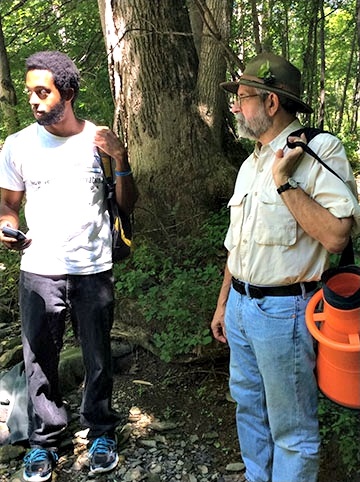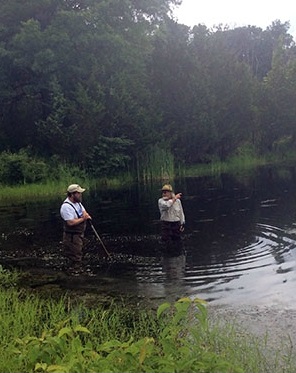
Photo: Alexander Mrvicka, Bugwood.org
Chinese Pond Mussel Project
The Hunt Is On for Invasive Mussels in Hunterdon County
People who live and travel along the numerous waterways in Hunterdon County often see anglers casting lines in the water in hopes of catching a fish for sport or for dinner, but in the summer of 2015, a new breed of hunter could be spotted along the shores of ponds, creeks and rivers in one section of the county. These folks didn’t carry fishing poles. Instead, they toted plastic bags, giant bright orange cones and cell phones enabled with both gps tracking devices and cameras. They traveled along shorelines for hours at a stretch in a slow walk characterized by bowed heads and hunched-over shoulders. It was obvious that they were looking for something…

Who are these people, why were they in the water, and what were they searching for? They are citizen-scientists who volunteered their time to look for Sinanodonta woodiana, a species of freshwater mollusk commonly known as the Chinese pond mussel. As its name suggests, the mussel not native to North America. It has proven to be troublesome in regions outside eastern Russia and China (its native range) – it has spread across Europe, Central America and the Indonesian Islands, where it has crowded out native mussels.
Chinese pond mussels didn’t start moving around the world all on their own. They have inadvertently been transported to new locations by humans importing and then raising fish. The larvae of Chinese pond mussels, known as glochidia, are parasites on fish and a small number of other aquatic vertebrates. The glochidia have essentially hitchhiked across the globe and established new populations in many of the places where fish are being farmed.
In 2007, a 51-acre property at the headwaters of the Wickecheoke Creek was acquired by the New Jersey Conservation Foundation (NJCF) as part of its Wickecheoke Creek Preserve. The land was once the site of a commercial fish-farming business. For 35 years, Thomas Huey, the first farmer in America to raise grass carp, operated an aquaculture business from the property. He imported carp fingerlings from China to raise in eight spring-fed ponds, then harvested and sold the grown fish to wholesalers in New York’s Chinatown.

As the staff from NJCF began stewardship work on the property, they discovered bighead carp living in the ponds. The presence of this highly invasive species surprised and worried them since the ponds drain into the Wikecheoke watershed, which in turn drains into the Delaware River. In 2010, when they began their efforts to eradicate the bighead carp to keep them from spreading, they noticed clam-like mollusks in the ponds that no one recognized so they contacted us to ask for help. It took quite a bit of work – we called in experts from the New Jersey Endangered & Nongame Species Program and the North Carolina State Museum of Natural Sciences to help – and eventually the mollusks were identified through DNA testing as Sinanodonta woodiana. It was the first time the species had been documented in North America.
The rotenone applied to the ponds to eradicate the invasive carp also killed most of the Chinese pond mussels, but live specimens have been found in the ponds since then, and shells have been found along creek beds downstream. In 2015, the Strike Team and its partners decided it was time to determine if/where the Chinese pond mussels have spread and to eliminate them once and for all. The Strike Team applied for and was awarded grant funding from the State through its Conserve Wildlife Matching Grants Program and from the Franklin Parker Conservation Excellence Grants Program for a project to methodically survey the Wickecheoke Creek watershed for Chinese pond mussels, kill any remaining living Chinese pond mussels in the ponds and develop a plan to eradicate any additional live populations found through the surveys.

In July, staff and volunteers from the Strike Team, NJCF and the Hunterdon Land Trust received training from state mussel experts and then divvied up the search area and began the painstaking work to carefully look for live Chinese pond mussels and the shells of dead ones through the 14 miles of waterways that drain the Wickecheoke Creek watershed.
By the end of autumn, our group had covered more than 10 miles of streams. We didn’t find any living specimens outside the immediate aquaculture pond area, but we don’t begrudge the hours spent searching for things we didn’t find – it actually made us very happy to end our searches empty-handed. It’s rewarding to be involved in an effort that lets us know our waterways are safe from the threat that this species presents. Out of 12 native species of freshwater mussels in New Jersey, 9 are classified as Endangered, Threatened, or Species of Special Concern. They certainly don’t need any competition from Chinese pond mussels!
It is our hope that all the mussels that survived the eradication treatments stayed within the ponds, but we’ll only know if the Delaware River ecosystem is safe from this population by continuing to monitor the waterways!
